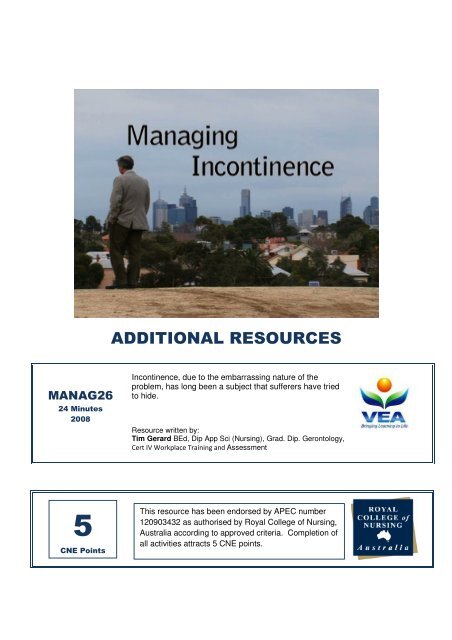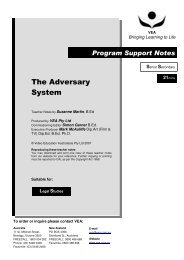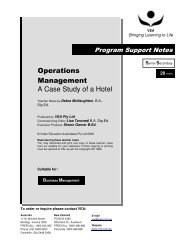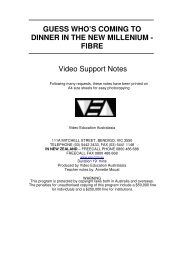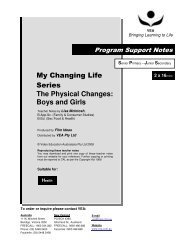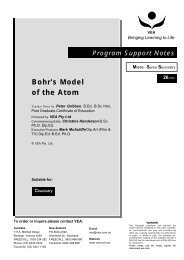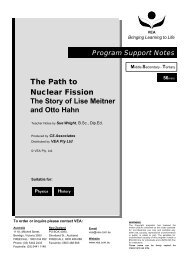ADDITIONAL RESOURCES - VEA
ADDITIONAL RESOURCES - VEA
ADDITIONAL RESOURCES - VEA
Create successful ePaper yourself
Turn your PDF publications into a flip-book with our unique Google optimized e-Paper software.
<strong>ADDITIONAL</strong> <strong>RESOURCES</strong><br />
MANAG26<br />
24 Minutes<br />
2008<br />
Incontinence, due to the embarrassing nature of the<br />
problem, has long been a subject that sufferers have tried<br />
to hide.<br />
Resource written by:<br />
Tim Gerard BEd, Dip App Sci (Nursing), Grad. Dip. Gerontology,<br />
Cert IV Workplace Training and Assessment<br />
5<br />
CNE Points<br />
This resource has been endorsed by APEC number<br />
120903432 as authorised by Royal College of Nursing,<br />
Australia according to approved criteria. Completion of<br />
all activities attracts 5 CNE points.
Managing Incontinence<br />
Introduction<br />
These additional resources and activities are designed for use in conjunction with the video content:<br />
- for individual and/or group learning in a formalised training environment<br />
- for individual self-paced and self directed learning<br />
- for accredited, self-directed nursing professional development – appropriate Continuing Nurse<br />
Education points are indicated below:<br />
Activity<br />
CNE points<br />
Activity Set One: Reflection and Comprehension* 2<br />
Activity Set Two: Application of knowledge 2<br />
Activity Set Three: Professional resource review 1<br />
Total possible CNE points: 5<br />
*includes time for viewing video once or twice<br />
Description of Video Content<br />
Incontinence, due to the embarrassing nature of the problem, has long been a subject that sufferers have<br />
tried to hide. This reluctance to disclose their problems and seek treatment and advice from health<br />
professionals has meant many sufferers remain socially isolated because of the fear, embarrassment and<br />
loss of dignity related to possible incidents of public incontinence. In addition to their feelings of shame<br />
and embarrassment the extra financial burdens of laundering, clothes replacement, appliances and aids<br />
costs can have devastating effects for some people. Sometimes these added burdens can lead to more<br />
severe disorders such as anxiety, stress disorders and clinical depression for the sufferer.<br />
Timeline<br />
00:00:00 Introduction<br />
00:00:59 An Introduction to Incontinence<br />
00:04:36 Types of Incontinence: Stress and Urge<br />
00:08:46 Types of Incontinence: Functional<br />
00:12:05 Types of Incontinence: Overflow and Enuresis<br />
00:16:20 Types of Incontinence: Faecal<br />
00:19:53 Strategies to Assist<br />
00:23:51 Conclusion<br />
00:24:16 Credits<br />
00:25:22 End Program<br />
Related Titles<br />
Geriatrics<br />
Nutrition and Ageing<br />
Ageing Populations<br />
Ageing Well<br />
2<br />
© <strong>VEA</strong> Group Pty Ltd 2013<br />
Reproducing these support notes<br />
You may download and print one copy of these support notes from our website or ClickView for your reference.<br />
Further copying or printing must be reported to CAL as per the Copyright Act 1968.
Managing Incontinence<br />
Activity Set One – Reflection and Comprehension<br />
This set of activities starts with three questions for reflection prior to viewing the video content. You may<br />
or may not wish to write down some responses. If you are in a group-learning environment, share those<br />
thoughts and reflections.<br />
The following 22 questions relate directly to your understanding of the material covered in the video.<br />
Space has been provided to write down responses to these questions.<br />
Reflective questions<br />
1. Think of how you might feel, and what you would do, if you were incontinent in any of the following<br />
locations:<br />
a) staying overnight at a friend’s house and finding the bed wet in the morning<br />
____________________________________________________________________________________<br />
____________________________________________________________________________________<br />
____________________________________________________________________________________<br />
b) walking down a very busy street<br />
____________________________________________________________________________________<br />
____________________________________________________________________________________<br />
____________________________________________________________________________________<br />
c) riding on crowded public transport<br />
____________________________________________________________________________________<br />
____________________________________________________________________________________<br />
____________________________________________________________________________________<br />
3<br />
© <strong>VEA</strong> Group Pty Ltd 2013<br />
Reproducing these support notes<br />
You may download and print one copy of these support notes from our website or ClickView for your reference.<br />
Further copying or printing must be reported to CAL as per the Copyright Act 1968.
Managing Incontinence<br />
2. Consider the emotions and feelings that sufferers of incontinence might experience. Make a list of at<br />
least six emotions or feelings.<br />
____________________________________________________________________________________<br />
____________________________________________________________________________________<br />
____________________________________________________________________________________<br />
____________________________________________________________________________________<br />
____________________________________________________________________________________<br />
____________________________________________________________________________________<br />
3. List reasons why you think incontinence might be something of a “taboo” subject that people don’t like<br />
to talk about.<br />
____________________________________________________________________________________<br />
____________________________________________________________________________________<br />
____________________________________________________________________________________<br />
____________________________________________________________________________________<br />
____________________________________________________________________________________<br />
____________________________________________________________________________________<br />
Questions specifically relating to video content<br />
4. Fill in the missing words to complete this definition of incontinence:<br />
Incontinence is the _____________ or_____________ loss of _____________ from the<br />
_____________ or _____________ or _____________ from the_____________.<br />
5. Women are twice as likely to suffer from incontinence as men.<br />
TRUE<br />
FALSE<br />
6. Circle all responses: The kinds of behaviours that sufferers of incontinence may be likely to exhibit.<br />
increase fluid intake decrease fluid intake wear dark clothing<br />
wear light coloured clothing<br />
decrease going out and socialising<br />
increase going out and socialising<br />
avoid places with accessible toilets<br />
4<br />
© <strong>VEA</strong> Group Pty Ltd 2013<br />
Reproducing these support notes<br />
You may download and print one copy of these support notes from our website or ClickView for your reference.<br />
Further copying or printing must be reported to CAL as per the Copyright Act 1968.
Managing Incontinence<br />
7. What percentage of bladder and bowel problems can be reduced by simple measures?<br />
30% 50% 70% 90%<br />
Types of Incontinence: Stress and Urge Incontinence<br />
8. Circle any of the following that could cause an episode of stress urinary incontinence.<br />
sneezing yawning coughing sleeping laughing<br />
lifting exercising blinking a sudden fright or scare<br />
9. Performing pelvic floor exercises is a good way for men and women to strengthen pelvic floor muscles<br />
and decrease the likelihood of episodes of stress and urge urinary incontinence.<br />
TRUE<br />
FALSE<br />
10. Urge urinary incontinence is caused by an overactive bladder for which there may be many causes.<br />
List five possible causes.<br />
____________________________________________________________________________________<br />
____________________________________________________________________________________<br />
____________________________________________________________________________________<br />
____________________________________________________________________________________<br />
____________________________________________________________________________________<br />
11. List three types of food or drink that may irritate the bladder causing episodes of urge urinary<br />
incontinence.<br />
____________________________________________________________________________________<br />
____________________________________________________________________________________<br />
____________________________________________________________________________________<br />
Types of Incontinence: Functional Incontinence<br />
12. Functional urinary incontinence may be caused by one or both of either mental or physical disabilities<br />
and is the most common form of urinary incontinence in the elderly residents of residential aged care<br />
services.<br />
TRUE<br />
FALSE<br />
5<br />
© <strong>VEA</strong> Group Pty Ltd 2013<br />
Reproducing these support notes<br />
You may download and print one copy of these support notes from our website or ClickView for your reference.<br />
Further copying or printing must be reported to CAL as per the Copyright Act 1968.
Managing Incontinence<br />
13. People with Alzheimer’s disease or dementia may not recognise the urge to urinate or be able to plan<br />
a trip to the toilet.<br />
TRUE<br />
FALSE<br />
14. Treatment and management of functional urinary incontinence may involve all or some of the<br />
following: improving functional status and physical strength, reducing environmental obstacles to<br />
toilets, bladder retraining and timed toilet scheduling.<br />
TRUE<br />
FALSE<br />
Types of Incontinence: Overflow and Enuresis/Bed Wetting<br />
15. Which of the following is NOT a symptom of overflow urinary incontinence? Circle your response.<br />
bladder distension<br />
straining to pass urine<br />
reduced urine flow and changes to the urine stream flow<br />
urinating less than three times a day<br />
16. Which of the following is NOT a treatment or management strategy for overflow urinary incontinence?<br />
Circle your response.<br />
surgery medication meditation<br />
Crede’s manoeuvre<br />
indwelling catheters<br />
17. Enuresis, or nocturnal bed wetting, can be treated by any of the following: surgical repair of physical<br />
injury or trauma, decreasing evening fluid intake, changing sleep patterns and pelvic floor exercises.<br />
TRUE<br />
FALSE<br />
Types of Incontinence: Faecal Incontinence<br />
18. List four possible causes of constipation.<br />
____________________________________________________________________________________<br />
____________________________________________________________________________________<br />
____________________________________________________________________________________<br />
____________________________________________________________________________________<br />
6<br />
© <strong>VEA</strong> Group Pty Ltd 2013<br />
Reproducing these support notes<br />
You may download and print one copy of these support notes from our website or ClickView for your reference.<br />
Further copying or printing must be reported to CAL as per the Copyright Act 1968.
Managing Incontinence<br />
19. List four possible causes of diarrhoea.<br />
____________________________________________________________________________________<br />
____________________________________________________________________________________<br />
____________________________________________________________________________________<br />
____________________________________________________________________________________<br />
20. List four types of food or drink that should be avoided when suffering faecal incontinence.<br />
____________________________________________________________________________________<br />
____________________________________________________________________________________<br />
____________________________________________________________________________________<br />
____________________________________________________________________________________<br />
Strategies to Assist in Managing Incontinence<br />
21. List four different types of products available to assist sufferers and carers to manage incontinence in<br />
the home or residential care setting.<br />
____________________________________________________________________________________<br />
____________________________________________________________________________________<br />
____________________________________________________________________________________<br />
____________________________________________________________________________________<br />
For nursing professional development, when used in conjunction with the video content, completion of<br />
this activity set carries 2 CNE points<br />
7<br />
© <strong>VEA</strong> Group Pty Ltd 2013<br />
Reproducing these support notes<br />
You may download and print one copy of these support notes from our website or ClickView for your reference.<br />
Further copying or printing must be reported to CAL as per the Copyright Act 1968.
Managing Incontinence<br />
Activity Set Two: Application of knowledge<br />
You have become aware that an elderly person you know or care for has been trying to hide evidence of<br />
his or her problems with maintaining urinal continence.<br />
1. How would you approach this person about the problem?<br />
2. What advice would you suggest to them?<br />
3. How might you go about helping them manage their problem?<br />
4. Research how constipation can cause faecal incontinence – a common condition in the aged.<br />
For nursing professional development, when used in conjunction with the video content, completion of<br />
this activity set carries 2 CNE points<br />
Activity Set Three: Professional resource review<br />
Summarise and review this video resource, commenting on:<br />
- what is covered by the content (aim for a 150 word summary)<br />
- to whom is the content targeted<br />
- its usefulness and relevance to that target group<br />
- the effectiveness of content delivery<br />
- strengths and limitations you perceive in the video resource<br />
A review is heavily opinionative by its nature – draw on the video content and your professional<br />
knowledge and experience to explain and/or justify any opinions you express, or recommendations you<br />
make, in the review.<br />
For nursing professional development, when used in conjunction with the video content, completion of<br />
this activity carries 1 CNE point<br />
8<br />
© <strong>VEA</strong> Group Pty Ltd 2013<br />
Reproducing these support notes<br />
You may download and print one copy of these support notes from our website or ClickView for your reference.<br />
Further copying or printing must be reported to CAL as per the Copyright Act 1968.
Managing Incontinence<br />
Suggested Responses to Activity Set One: Reflection and Comprehension<br />
Questions specifically relating to video content<br />
4. Fill in the missing words to complete this definition of incontinence:<br />
Incontinence is the accidental or involuntary loss of urine from the bladder or faeces or wind from<br />
the bowel.<br />
5. Women are twice as likely to suffer from incontinence as men.<br />
TRUE<br />
FALSE<br />
6. Circle all responses: The kinds of behaviours that sufferers of incontinence may be likely to exhibit.<br />
increase fluid intake decrease fluid intake wear dark clothing<br />
wear light coloured clothing<br />
decrease going out and socialising<br />
increase going out and socialising<br />
avoid places with accessible toilets<br />
7. What percentage of bladder and bowel problems can be reduced by simple measures?<br />
30% 50% 70% 90%<br />
Types of Incontinence: Stress and Urge Incontinence<br />
8. Circle any of the following that could cause an episode of stress urinary incontinence.<br />
sneezing yawning coughing sleeping laughing<br />
lifting exercising blinking a sudden fright or scare<br />
9. Performing pelvic floor exercises is a good way for men and women to strengthen pelvic floor muscles<br />
and decrease the likelihood of episodes of stress and urge urinary incontinence.<br />
TRUE<br />
FALSE<br />
10. Urge urinary incontinence is caused by an overactive bladder for which there may be many causes.<br />
List five possible causes.<br />
Stress<br />
Anxiety<br />
Bladder infection<br />
Prostate disease<br />
Diabetes<br />
Stroke<br />
Medications<br />
11. List three types of food or drink that may irritate the bladder causing episodes of urge urinary<br />
incontinence.<br />
Coffee<br />
Alcohol<br />
Citrus fruits and juices<br />
9<br />
© <strong>VEA</strong> Group Pty Ltd 2013<br />
Reproducing these support notes<br />
You may download and print one copy of these support notes from our website or ClickView for your reference.<br />
Further copying or printing must be reported to CAL as per the Copyright Act 1968.
Managing Incontinence<br />
Types of Incontinence: Functional Incontinence<br />
12. Functional urinary incontinence may be caused by one or both of either mental or physical disabilities<br />
and is the most common form of urinary incontinence in the elderly residents of residential aged care<br />
services.<br />
TRUE<br />
FALSE<br />
13. People with Alzheimer’s disease or dementia may not recognise the urge to urinate or be able to plan<br />
a trip to the toilet.<br />
TRUE<br />
FALSE<br />
14. Treatment and management of functional urinary incontinence may involve all or some of the<br />
following: improving functional status and physical strength, reducing environmental obstacles to<br />
toilets, bladder retraining and timed toilet scheduling.<br />
TRUE<br />
FALSE<br />
Types of Incontinence: Overflow and Enuresis/Bed Wetting<br />
15. Which of the following is NOT a symptom of overflow urinary incontinence? Circle your response.<br />
bladder distension<br />
straining to pass urine<br />
reduced urine flow and changes to the urine stream flow<br />
urinating less than three times a day<br />
16. Which of the following is NOT a treatment or management strategy for overflow urinary incontinence?<br />
Circle your response.<br />
surgery medication meditation<br />
Crede’s manoeuvre<br />
indwelling catheters<br />
17. Enuresis, or nocturnal bed wetting, can be treated by any of the following: surgical repair of physical<br />
injury or trauma, decreasing evening fluid intake, changing sleep patterns and pelvic floor exercises.<br />
TRUE<br />
FALSE<br />
Types of Incontinence: Faecal Incontinence<br />
18. List four possible causes of constipation.<br />
Lack of fibre in diet<br />
Too much fibre in diet<br />
Decreased fluid intake<br />
Decreased exercise<br />
Some medications<br />
Nerve damage<br />
Bowel disease or disorders: haemorrhoids, irritable bowel syndrome<br />
10<br />
© <strong>VEA</strong> Group Pty Ltd 2013<br />
Reproducing these support notes<br />
You may download and print one copy of these support notes from our website or ClickView for your reference.<br />
Further copying or printing must be reported to CAL as per the Copyright Act 1968.
Managing Incontinence<br />
19. List four possible causes of diarrhoea.<br />
Laxative misuse<br />
Bowel or stomach infection<br />
Bowel disease<br />
Some medications<br />
Food allergies<br />
Food intolerances<br />
Alcohol<br />
Radiotherapy<br />
20. List four types of food or drink that should be avoided when suffering faecal incontinence.<br />
Excessive coffee<br />
Excessive alcohol<br />
Too much fruit<br />
Spicy and fatty foods<br />
Dairy products<br />
Artificial sweeteners<br />
Cured meats<br />
Strategies to Assist in Managing Incontinence<br />
21. List four different types of products available to assist sufferers and carers to manage incontinence in<br />
Light, medium or heavy incontinence pads or nappies<br />
Male pads or sheaths<br />
Absorbent bed sheets<br />
Condom/uridome drainage<br />
Specialised easy on/off clothing<br />
11<br />
© <strong>VEA</strong> Group Pty Ltd 2013<br />
Reproducing these support notes<br />
You may download and print one copy of these support notes from our website or ClickView for your reference.<br />
Further copying or printing must be reported to CAL as per the Copyright Act 1968.


